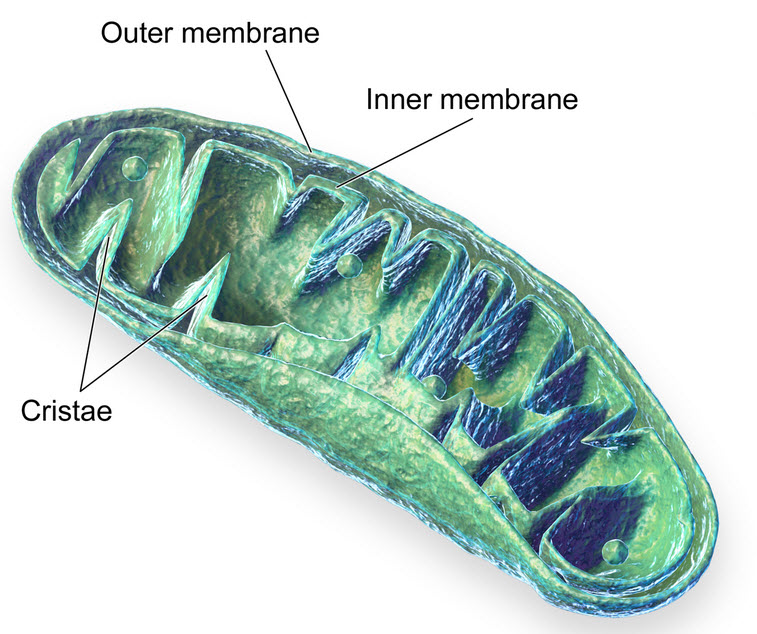‘Rewired’ mice show signs of longer lives with fewer age-related illnesses
August 5, 2014

Mitochondrion (credit: BruceBlaus/Creative Commons)
Mice lacking a specific protein (TRAP-1) live longer lives with fewer age-related illnesses, such as tissue degeneration, obesity, and spontaneous tumor formation, when compared with normal mice, researchers at The Wistar Institute have discovered.
In healthy cells, TRAP-1 is an important regulator of metabolism and has been shown to regulate energy production in mitochondria, which are organelles that generate chemically useful energy for the cell.
In the mitochondria of cancer cells, TRAP-1 is universally overproduced.
The Wistar team’s report appears in the journal Cell Reports (open access). It shows that “knockout” (genetically modified) mice bred to lack the TRAP-1 protein “show fewer signs of aging and are less likely to develop cancers,” said Dario C. Altieri. M.D., Robert and Penny Fox Distinguished Professor and director of The Wistar Institute’s National Cancer Institute-designated Cancer Center. “Our findings provide an unexpected explanation for how TRAP-1 and related proteins regulate metabolism within our cells.”
Slowing cell growth down to enable repair
The researchers found that in their knockout mice, the loss of TRAP-1 causes mitochondrial proteins to misfold, which then triggers a compensatory response that causes cells to consume more oxygen and metabolize more sugar. This causes mitochondria in knockout mice to produce deregulated levels of ATP, the chemical used as an energy source to power all the everyday molecular reactions that allow a cell to function.
This increased mitochondrial activity actually creates a moderate boost in oxidative stress (“free radical damage”) and the associated DNA damage. While DNA damage may seem counterproductive to longevity and good health, the low level of DNA damage actually reduces cell proliferation — slowing growth down to allow the cell’s natural repair mechanisms to take effect.
“Our findings strengthen the case for targeting HSP90 in tumor cells, but they also open up a fascinating array of questions that may have implications for metabolism and longevity,” Altieri said. “I predict that the TRAP-1 knockout mouse will be a valuable tool for answering these questions.”
This work was supported by grants to Altieri from the National Institutes of Health and the Office of the Assistant Secretary of Defense for Health Affairs through the Prostate Cancer Research Program. Additional support was provided through the National Cancer Institute Cancer Center Support Grant to The Wistar Institute.
Researchers at the University of Pennsylvania School of Veterinary Medicine and Thomas Jefferson University were also involved in the study.
The Wistar Institute | Wistar postdoctoral fellow Sofia Lisanti discusses a recent study on an important cancer drug target, the TRAP-1 protein. Mice without TRAP-1 live healthier, with fewer tumors and signs of aging.
Abstract of Cell Reports paper
- TRAP-1 knockout mice have reduced age-associated pathologies
- Loss of TRAP-1 upregulates oxidative phosphorylation and glycolysis transcriptomes
- TRAP-1-deleted cells have deregulated mitochondrial respiration and enhanced glycolysis
- TRAP-1 deletion induces oxidative stress, DNA damage, and reduced cell proliferation
Reprogramming of metabolic pathways contributes to human disease, especially cancer, but the regulators of this process are unknown. Here, we have generated a mouse knockout for the mitochondrial chaperone TRAP-1, a regulator of bioenergetics in tumors. TRAP-1−/− mice are viable and showed reduced incidence of age-associated pathologies, including obesity, inflammatory tissue degeneration, dysplasia, and spontaneous tumor formation. This was accompanied by global upregulation of oxidative phosphorylation and glycolysis transcriptomes, causing deregulated mitochondrial respiration, oxidative stress, impaired cell proliferation, and a switch to glycolytic metabolism in vivo. These data identify TRAP-1 as a central regulator of mitochondrial bioenergetics, and this pathway could contribute to metabolic rewiring in tumors.